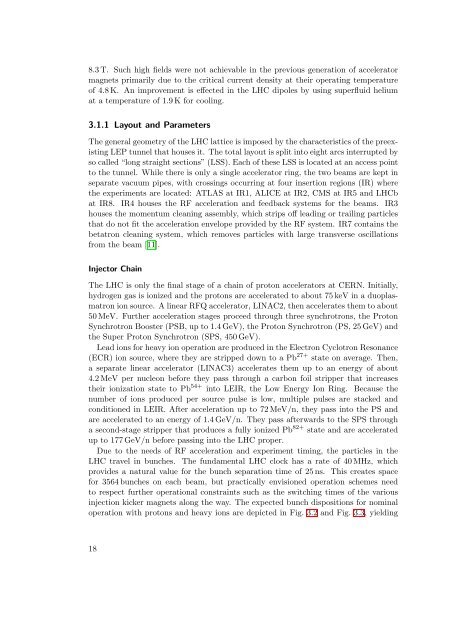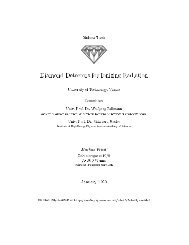You also want an ePaper? Increase the reach of your titles
YUMPU automatically turns print PDFs into web optimized ePapers that Google loves.
8.3 T. Such high fields were not achievable in the previous generation of acceleratormagnets primarily due to the critical current density at their operating temperatureof 4.8 K. An improvement is effected in the LHC dipoles by using superfluid heliumat a temperature of 1.9 K for cooling.3.1.1 Layout and ParametersThe general geometry of the LHC lattice is imposed by the characteristics of the preexistingLEP tunnel that houses it. The total layout is split into eight arcs interrupted byso called “long straight sections” (LSS). Each of these LSS is located at an access pointto the tunnel. While there is only a single accelerator ring, the two beams are kept inseparate vacuum pipes, with crossings occurring at four insertion regions (IR) wherethe experiments are located: ATLAS at IR1, ALICE at IR2, CMS at IR5 and LHCbat IR8. IR4 houses the RF acceleration and feedback systems for the beams. IR3houses the momentum cleaning assembly, which strips off leading or trailing particlesthat do not fit the acceleration envelope provided by the RF system. IR7 contains thebetatron cleaning system, which removes particles with large transverse oscillationsfrom the beam [11].Injector ChainThe LHC is only the final stage of a chain of proton accelerators at CERN. Initially,hydrogen gas is ionized and the protons are accelerated to about 75 keV in a duoplasmatronion source. A linear RFQ accelerator, LINAC2, then accelerates them to about50 MeV. Further acceleration stages proceed through three synchrotrons, the ProtonSynchrotron Booster (PSB, up to 1.4 GeV), the Proton Synchrotron (PS, 25 GeV) andthe Super Proton Synchrotron (SPS, 450 GeV).Lead ions for heavy ion operation are produced in the Electron Cyclotron Resonance(ECR) ion source, where they are stripped down to a Pb 27+ state on average. Then,a separate linear accelerator (LINAC3) accelerates them up to an energy of about4.2 MeV per nucleon before they pass through a carbon foil stripper that increasestheir ionization state to Pb 54+ into LEIR, the Low Energy Ion Ring. Because thenumber of ions produced per source pulse is low, multiple pulses are stacked andconditioned in LEIR. After acceleration up to 72 MeV/n, they pass into the PS andare accelerated to an energy of 1.4 GeV/n. They pass afterwards to the SPS througha second-stage stripper that produces a fully ionized Pb 82+ state and are acceleratedup to 177 GeV/n before passing into the LHC proper.Due to the needs of RF acceleration and experiment timing, the particles in theLHC travel in bunches. The fundamental LHC clock has a rate of 40 MHz, whichprovides a natural value for the bunch separation time of 25 ns. This creates spacefor 3564 bunches on each beam, but practically envisioned operation schemes needto respect further operational constraints such as the switching times of the variousinjection kicker magnets along the way. The expected bunch dispositions for nominaloperation with protons and heavy ions are depicted in Fig. 3.2 and Fig. 3.3, yielding18












